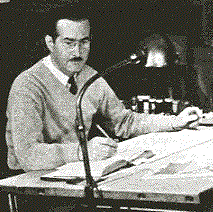Boris Artzybasheff facts for kids
Boris Mikhailovich Artzybasheff was a famous Russian-American artist. He was known for his strong and often unusual designs. Boris was born in Kharkov, Russia, on May 25, 1899. He later moved to the United States and became a very important illustrator. He passed away on July 16, 1965.
Contents
Life and Amazing Art Career
Boris Artzybasheff was born in Kharkov. His father, Mikhail Artsybashev, was a writer. Boris came to New York City in 1919. He started working in a shop that made engravings.
Early Works and Book Illustrations
Boris's first art appeared in 1922. He illustrated books like Verotchka's Tales. Many other books followed in the 1920s. One book he illustrated was Gay Neck, the Story of a Pigeon. This book won the Newbery Medal in 1928. The Newbery Medal is a special award for children's books.
His own book, Seven Simeons, was also honored. It was a Caldecott Honor Book in 1938. This award is for great picture books for children. Boris illustrated about 50 books in his life. He even wrote some of them himself, like As I See.
Magazine Art and Famous Covers
Boris Artzybasheff was very well known for his magazine art. He drew for major American magazines. These included Life, Fortune, and Time. He created 219 Time magazine covers. These covers featured many famous people. Some examples are musician Louis Armstrong and composer Dmitri Shostakovich.
Helping During World War II
During World War II, Boris also helped the U.S. government. He advised the U.S. Department of State. His work helped with communication and public information during the war.
Commercial Art and Unique Style
After 1940, Boris focused on commercial art. This means he created art for advertisements. He made ads for big companies. Some of these were Xerox, Shell Oil, and Pan Am.
His art style was very striking and unique. For commercial work, he often drew machines that looked like people. For example, a machine might have human arms or faces. He also drew a portrait of Buckminster Fuller. This portrait showed Fuller's head as a geodesic dome. It was on the cover of TIME magazine in 1964. Later, it was even put on a U.S. postage stamp! In his personal art, he explored how people think and feel.
His collected artworks and papers are kept at Syracuse University.
Selected Books with Art by Boris
Here are some of the books Boris Artzybasheff illustrated:
- Verotchka's Tales, by Dmitry Mamin-Sibiryak (1922)
- The Undertaker's Garland, by John Peale Bishop and Edmund Wilson (1922)
- Feats on the Fiord, by Harriet Martineau (1924)
- The Wonder Smith and His Son, by Ella Young (1927)
- Gay Neck, the Story of a Pigeon, by Dhan Gopal Mukerji (1927)
- Orpheus: Myths of the World, by Padraic Colum (1930)
- Son of the Sword, by Youel B. Mirza (1934)
- The Circus of Dr. Lao, by Charles G. Finney (1935)
- Seven Simeons: a Russian Tale, written by Artzybasheff (1937)
- Nansen, by Anne Gertrude Hall (1940)
- Land of Unreason, by Fletcher Pratt and L. Sprague de Camp (1942)
- The Tree of Life: Selections from the Literature of the World's Religions, by Ruth Smith (1942)
- The Little Sister, by Raymond Chandler (1949)
- The Simple Art of Murder, by Raymond Chandler (1950)
Boris Artzybasheff was a runner-up for the Caldecott Medal in 1938 for Seven Simeons. This award is given for the best children's picture book. The book Gay Neck, which he illustrated, won the Newbery Medal in 1928. This award is for the most important contribution to children's literature.


